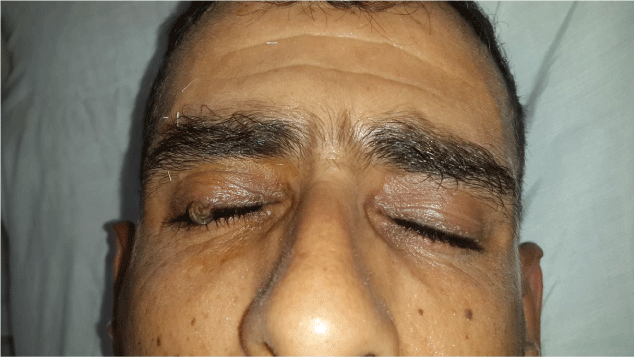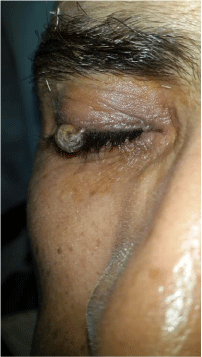Cutaneous horns are relatively rare tumors, the precursor lesions are multiple and variable. From where the interest of the histology to look for what is under a cutaneous horn.
Cutaneous horns are frequent keratinized epidermal growths that can have spectacular dimensions and shapes. Its etiologies are multiple and of variable gravities.
A 35-year-man, without significant pathological history, with a notion of significant solar exposure seen his profession. Has consulted for a verrucous tumor of the free edge of the right upper eyelid, obstructing the vision, longer than broad, measuring about one centimeter, rolled up on itself with an erythematous base surmounted by a yellow keratin (Figures 1 and Figure 2). View the young age of the patient, the typical character of the lesion and the first episode of the disease, an electro section with electrocoagulation were made. The evolution was marked by a complete remission over 12 months of decline.
Cutaneous horn is a relatively rare tumor, most often arising on sun-exposed skin in elderly men [1-4]. While the cause leading to the formation of cutaneous horns is unknown, UV radiations are believed to be the trigger of this condition [4].
Various types of associated lesions may be found at the base of a cutaneous horn, including viral warts, actinic keratosis, keratoacanthoma, seborrheic keratosis, histiocytoma pyogenic granuloma, follicular keratosis, verrucous epidermal nevus, moluscum contagiosum, discoid lupus erythematosus, Bowen's disease, basal cell carcinoma, and squamous cell carcinoma [2,4].
In a study performed on 48 cases with eyelid horns, by Mencía-Gutiérrez, et al. Histologically, 77.1% were associated with benign specimens at the base pathology, 14.6% were premalignant, and finally, 8.3% were caused by malignant skin tumors [2].
The treatment of choice is the biopsy exerese followed by a histological study, in cases of benign lesions; the biopsy may be both diagnostic and therapeutic, while for malignant tumors, complete surgical excision with appropriate margin is usually required [1,4].
The diagnosis of a cutaneous horn is often easy clinically. The important is not the horn itself, but the nature of the underlying disease. Then, the histology remains primordial in front of any cutaneous horn.

Figure 1: Keratin horn of the free edge of the upper right eyelid.

Figure 2: Keratin horn of the free edge of the upper right eyelid.